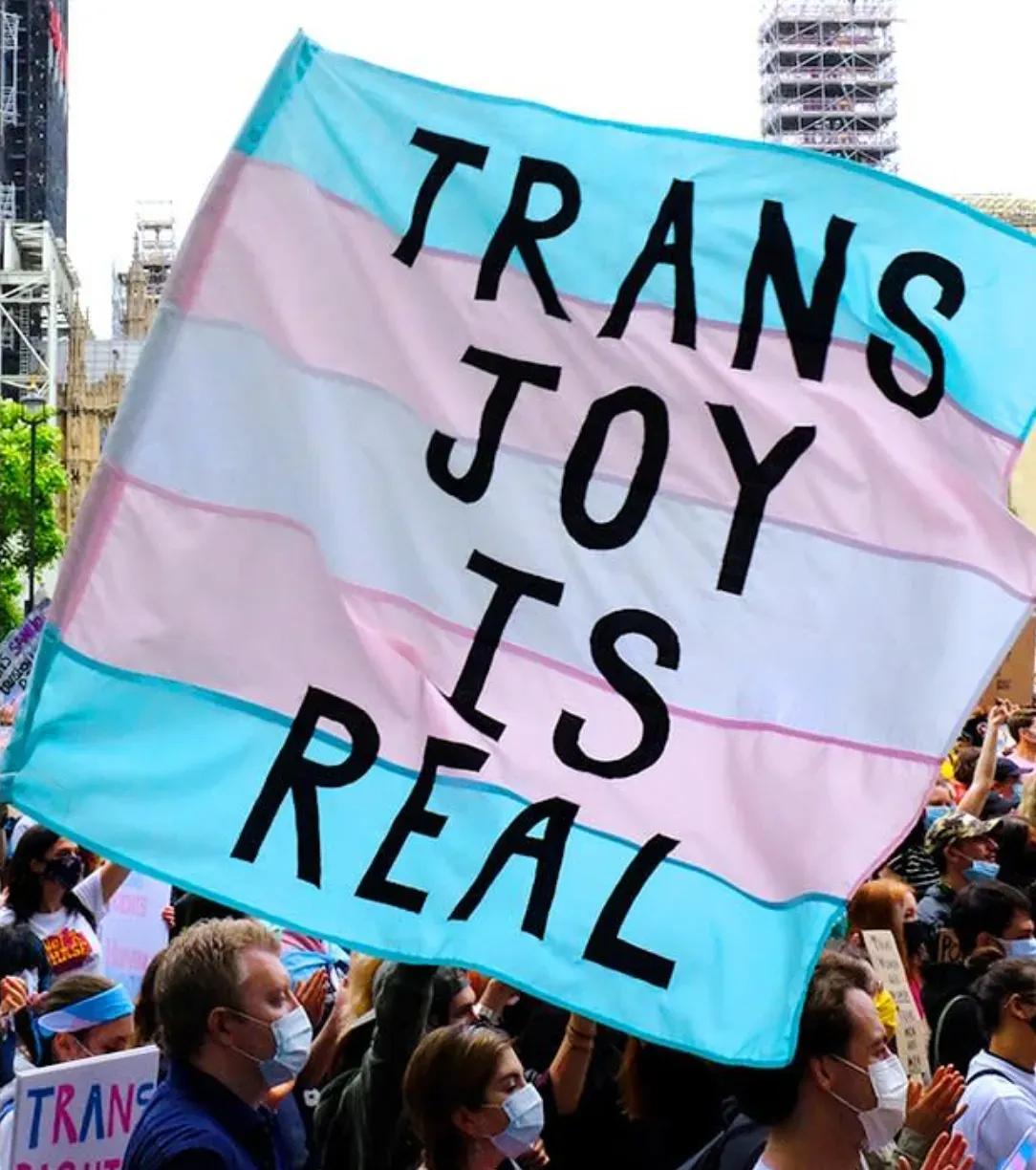Trans Joy: Because Apparently Happiness is Now a Conspiracy Theory

Folks, I've gotta tell you – I never thought I'd see the day when people being happy would be considered evidence of a global conspiracy. But here we are in 2025, and according to some corners of the internet, trans people experiencing joy is not just suspicious – it's apparently proof of a sinister plot by the "dystopian transhumanist elite" to... let me check my notes... "feed off the human body itself."
I can't make this stuff up.1
Today, we're looking at an article from Margox Substack that takes the revolutionary concept that transgender people might occasionally experience happiness and transforms it into the plot of a sci-fi horror movie that wouldn't even make it past the first draft at a B-movie studio. The logical leaps in this piece aren't just impressive – they qualify for Olympic gold in mental gymnastics.
Part 1: The Shocking Truth About Joy
The article begins by breathlessly documenting the terrifying epidemic of... trans people finding moments of happiness. The horror! The author lists various organizations and events celebrating "trans joy" as though they're documenting evidence of criminal activity.
What the author fails to mention is that these celebrations exist precisely because transgender people face disproportionate rates of depression, anxiety, and suicidal ideation – largely due to societal rejection, discrimination, and yes, articles exactly like the one they wrote. According to the Trevor Project's 2022 National Survey, 45% of LGBTQ+ youth seriously considered attempting suicide in the past year, with rates even higher among transgender and nonbinary youth. 2 Another study found that transgender individuals who experienced discrimination were significantly more likely to report symptoms of depression and anxiety.3
Let's apply this same logic to other contexts:
"Got 'cancer survivor joy'? Everyone else does. Relay for Life. Susan G. Komen. The American Cancer Society. They got it so bad they keep organizing walks and fundraisers. In Florida, 'cancer survivor joy' is being celebrated says NBC. In 2022, Survivor Centers opened in the area."
Sounds pretty silly when you put it that way, doesn't it? Celebrating resilience in the face of difficulty isn't evidence of a conspiracy – it's evidence of human perseverance.
Part 2: The Nefarious Plot of... checks notes... Research Ethics Boards?
The author then takes us on a meandering journey through Institutional Review Boards, CITI training, and academic research protocols. Apparently, asking researchers to consider the unique needs of diverse populations is also part of the grand conspiracy.
Here's a fun fact the author neglected to mention: The very same IRB standards they're criticizing were created to prevent unethical research practices like the Tuskegee Syphilis Study – when researchers deliberately withheld treatment from Black men with syphilis to observe the progression of the disease. 4 The Belmont Report, which forms the ethical foundation for human subjects research protections, specifically emphasizes justice in the selection of research subjects and respect for persons – principles that necessitate considering the unique needs of diverse populations.5
So let me get this straight – ensuring research doesn't harm vulnerable populations is now... bad? That's like saying seatbelts are a conspiracy by Big Safety to restrict your freedom of movement.
Part 3: The AI Joy Detector (Which Apparently Exists)
The author takes particular issue with a study that used AI to analyze social media posts by transgender individuals who had undergone top surgery. According to the author, this study was "strange and unethical" and "pure garbage."
What they conveniently omit is that similar sentiment analysis techniques are used across countless fields of research to better understand patient experiences. From cancer treatments to cardiac care, researchers analyze patient reports to improve outcomes.6 It's called patient-centered care, and it's generally considered a good thing.
The study in question actually identified a mismatch between surgeon aesthetic ratings and patient satisfaction – information that can help improve surgical techniques while recognizing that patient wellbeing involves more than just appearance. 7 That's not a conspiracy; that's just good medicine.
Part 4: The "Trans Agenda" Timeline (Now With More Fiction!)
My favorite part of the article has to be the implied timeline of the "trans agenda," where the author suggests that transgender rights activism is some recent invention that mysteriously appeared around 2011-2012.
In reality, organized activism for transgender rights dates back to at least the 1950s with organizations like the Mattachine Society and the Daughters of Bilitis, which included transgender members.8 The Compton's Cafeteria riot in 1966 and the Stonewall riots in 1969 were pivotal moments in transgender activism history – led in part by transgender women of color like Marsha P. Johnson and Sylvia Rivera. 9
I guess those inconvenient historical facts just didn't fit the narrative.
Part 5: The Joy Deficit
Now, here's the most fascinating part of all. The author dismissively mentions a study titled "Reducing the Joy Deficit in Sociology: A Study of Transgender Joy" as though the very concept is absurd.
What they fail to recognize is that focusing solely on trauma and victimhood in research about marginalized communities creates an incomplete picture. It's like if every study about Black Americans focused only on racism, or if every study about women focused only on sexism. By documenting joy alongside challenges, researchers create a more complete understanding of human experience. 10
The author suggests that "time and reality are telling the real human story" about transgender individuals. On this point, we actually agree – just not in the way they think.
The reality is that longitudinal studies consistently show that gender-affirming care improves mental health outcomes and quality of life for transgender individuals. In a 2021 review, 55 studies showed positive outcomes, and only 4 had mixed or null findings. Not a single study showed that gender-affirming care leads to worse outcomes.11 That's time and reality telling the real human story.
In Conclusion: The Real Conspiracy
You know what's interesting about conspiracy theories? They often accuse others of exactly what they themselves are doing.
The article claims there's a coordinated effort to promote a false narrative about transgender people. Meanwhile, well-funded organizations have spent millions promoting misleading information about transgender healthcare, systematically misrepresenting research, and crafting policy based on ideology rather than evidence. A 2021 Global Project Against Hate and Extremism report documented over $750 million flowing from US-based organizations to anti-gender campaigns worldwide. 12
Trans joy isn't a conspiracy or a catchphrase – it's simply the recognition that transgender people, like all people, deserve to experience happiness, fulfillment, and self-actualization. The real question isn't why so many organizations are celebrating trans joy – it's why anyone would find that threatening.
After all, if your worldview is threatened by other people's happiness, maybe it's time to reconsider your worldview, not their joy.
References
1 https://margox.substack.com/p/trans-joy
2 The Trevor Project. (2022). 2022 National Survey on LGBTQ Youth Mental Health. https://www.thetrevorproject.org/survey-2022/
3 Bockting, W. O., Miner, M. H., Swinburne Romine, R. E., Hamilton, A., & Coleman, E. (2013). Stigma, mental health, and resilience in an online sample of the US transgender population. American Journal of Public Health, 103(5), 943-951.
4 Centers for Disease Control and Prevention. (2021). The Tuskegee Timeline. U.S. Public Health Service Syphilis Study at Tuskegee. https://www.cdc.gov/tuskegee/timeline.htm
5 National Commission for the Protection of Human Subjects of Biomedical and Behavioral Research. (1979). The Belmont Report: Ethical principles and guidelines for the protection of human subjects of research. Department of Health, Education, and Welfare.
6 Greaves, F., Ramirez-Cano, D., Millett, C., Darzi, A., & Donaldson, L. (2013). Use of sentiment analysis for capturing patient experience from free-text comments posted online. Journal of Medical Internet Research, 15(11), e239.
7 Cuccolo, N. G., Kang, C. O., Boskey, E. R., Ibrahim, A. M. S., Blankensteijn, L. L., Taghinia, A. H., Tobias, A. M., Lee, B. T., & Alperovich, M. (2021). Analysis of chest masculinization surgery results in female-to-male transgender patients: Demonstrating high satisfaction beyond aesthetic outcomes using advanced linguistic analyzer technology and social media. Plastic and Reconstructive Surgery, 147(2), 371e-380e.
8 Stryker, S. (2017). Transgender History: The Roots of Today's Revolution (2nd ed.). Seal Press.
9 Pergadia, J. K. (2019). The history of transgender activism in the United States. LGBTQ Policy Journal at the Harvard Kennedy School, 9, 1-19.
10 Shuster, S. M., & Westbrook, L. (2022). Reducing the joy deficit in sociology: A study of transgender joy. Sociology Compass, 16(5), e12971.
11 Cornell University. (2021). What does the scholarly research say about the effect of gender transition on transgender well-being? What We Know Project. https://whatweknow.inequality.cornell.edu/topics/lgbt-equality/what-does-the-scholarly-research-say-about-the-well-being-of-transgender-people/
12 Global Project Against Hate and Extremism. (2021). The global anti-gender movement: How conservative groups are working to roll back human rights for women, LGBTQ+ and other marginalized communities. GPAHE Report.


